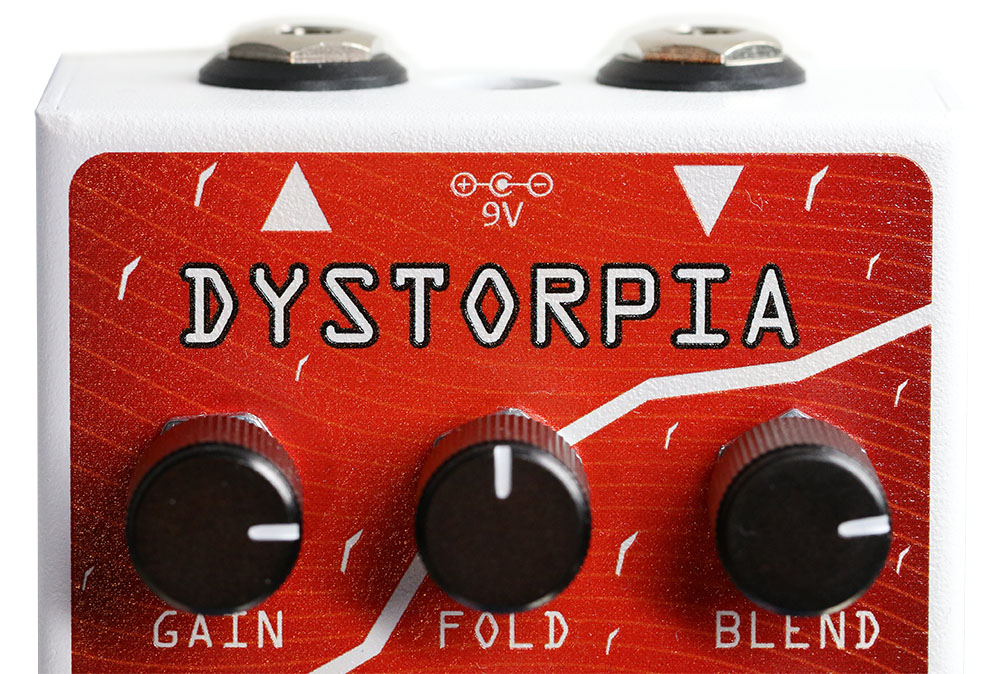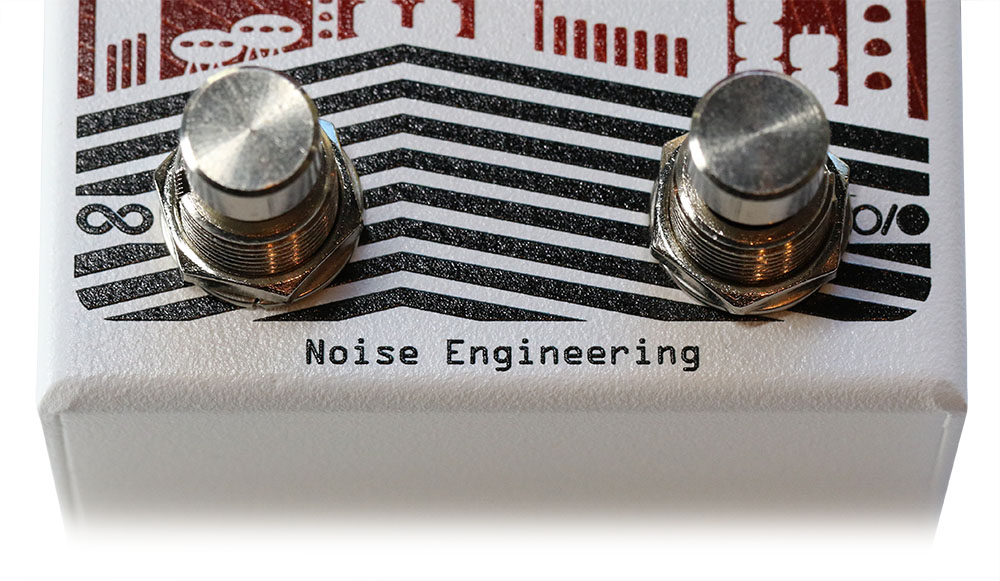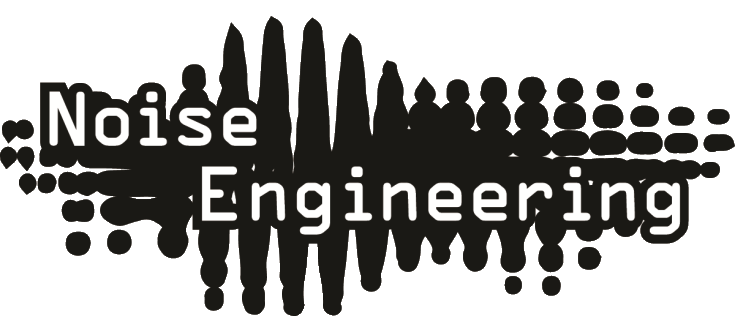Does the world really need another distortion guitar pedal? It’s certainly a valid question, considering how many signal-degrading effects are available. However, when the pedal comes the way of Noise Engineering, the answer is a big Yass!
Known more for their Eurorack modules, the boutique California concern has a distinctive product development mentality that yields products with a lot of deep thinking, and often some very pleasant surprises. It turns out their new distortion pedal, Dystorpia, is consistent with their bespoke approach.
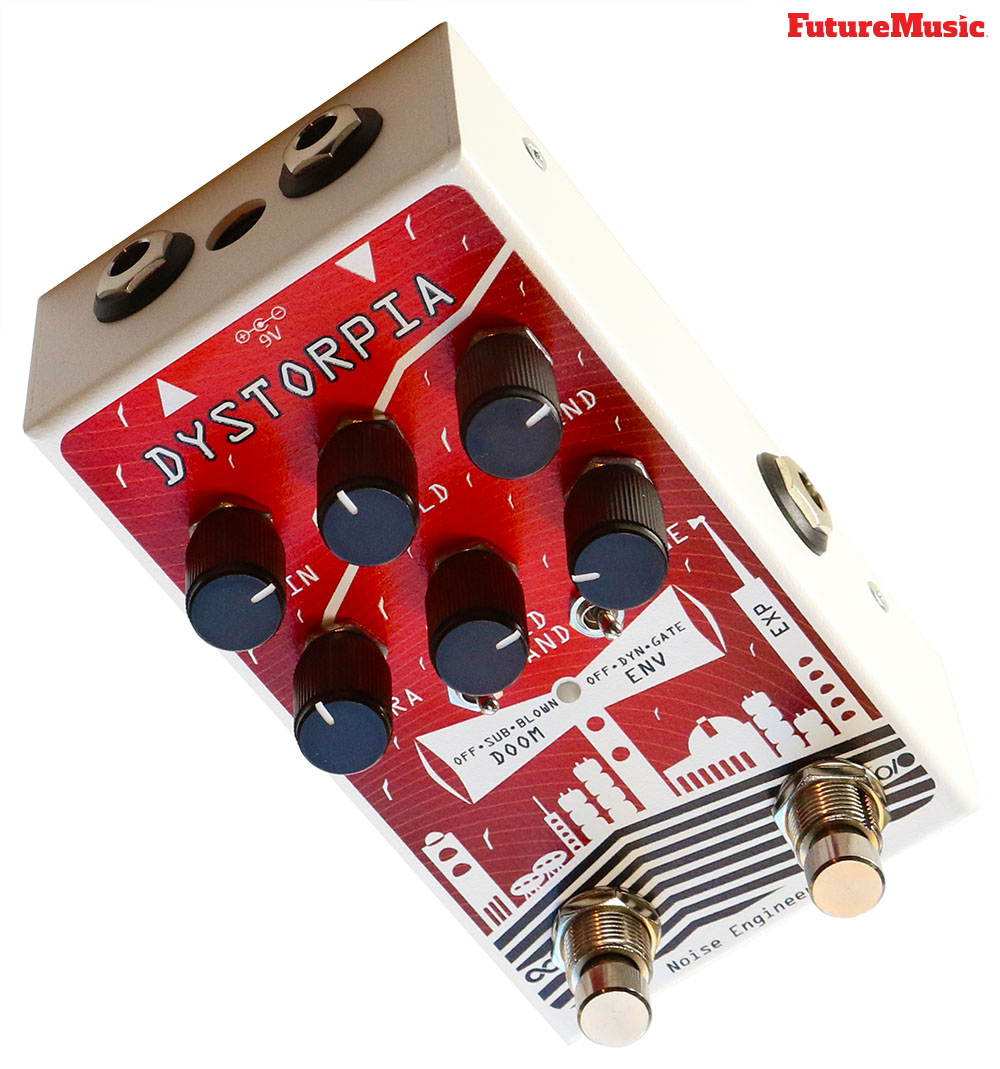

For a limited time only! Up to 80% off all Waves Bundles. PLUS click the banner above or the Go button for an additional 10%! This is Waves best deal yet! Get yours today before this special ends! Go!
Dystorpia is the company’s first guitar pedal. It takes the knowledge Noise garnered creating their Kith Ruina, Runia Versio, Terci Runia and Viol Ruina, as well as many of their other dynamic modules and funnels it into a guitar pedal that is anything but conventional. To get deeper into the weeds of Dystorpia’s development, we had an illuminating conversation with Kris Kaiser who’s official title at Noise is Doer Of Many Things. She’s an intricate part of the Noise engine and like many of the team members, has a very interesting background that delivers a diverse skill set. Plus, she’s into Aerials Silks and what’s cooler than that? Her intellect is peppered throughout this review – along with our five reviewers in quotes. But why would an Eurorack module maker start making guitar pedals?
Why would an Eurorack module maker start making guitar pedals?
“We have wanted to make guitar pedals for as long as we can remember,” declares Kris Kaiser. “Stephen (McCaul, Noise’s Chief Engineer) played bass and a bit of guitar before he got into synths, and we both have always been fascinated by the diversity of pedals out there. At the same time, we really thought we could bring something new and fresh to the pedal market.”
So what exactly is Dystorpia? Well, according to the dictionary, it’s a fictional or imaginary place where people live in a state of fear, dehumanization, and misery. Dystopias are often societies of the future that serve as a warning about what could happen if technology, industry, and government become more and more prominent in our everyday lives. Uplifting, right? Well, certainly not, but it’s a great name for a distortion pedal that delivers its own brand of mayhem.
In terms of a Noise Engineering guitar pedal, it turns out that Dystorpia is a fully digital, mono distortion with six knobs, two toggles and two buttons. The two buttons are Freeze on the left and On/Off on the right. Freeze can also be used to adjust the gain output when held down. The six buttons include Gain, Fold, Blend, Pura, Mid Band and Tone. Gain controls the volume of the input coming into the pedal. Fold pertains to the amount of Wavefolding applied to the input. For those unfamiliar with the concept, Wavefolding provides harmonic distortion by collapsing the signal unto itself, instead of clipping. As you increase the fold amount, the signal morphs into howls, barks, snarls, basically the bread and butter of Horror movies. Blend is self explanatory; it mixes the dry and wet signals, but it also adds a bit of saturation as you dial in the moisture.
Pura, which may ring a bell, if you’re familiar with Noise’s other offerings provides an unique fuzz component to the signal. As you turn it clockwise, it determines the amount of “full-wave rectification applied to the signal. This shifts the negative part of the waveform to the positive, resulting in a harmonically rich, buzzsaw fuzz,” according to Noise. Working in tandem with Fold, is where things get particularly interesting. There’s a dysfunctional relationship with how these two elements interact with each other to create a variety of intricate and nuanced tones. In terms of Dystorpia, our reviewers felt that the Fold feature is what the pedal competitively different than other offerings on the market, so we asked Kaiser to elaborate.
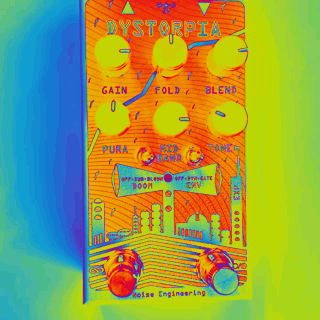
“Fold is a classic but really simple distortion technique in modular synthesis. The musician sets an amplitude and anytime the waveform crosses it, the folder flips it upside down. Fold can be inharmonic with complex inputs, but can also generate a wide variety of harmonics that are related to the signal but dependent on the current amplitude.”
“In synths, the levels are pretty fixed and very controllable, so fold works really well,” Kaiser continues. “Guitars – and any playable physical oscillator – are a bit trickier because they are so much more dynamic. Having a threshold-type effect on such a dynamic signal feels unnatural because a small change in amplitude often leads to a giant change in tone. Dystorpia fixes this problem by using an envelope follower to base the fold threshold on the input level. We intentionally made the envelope follower a little messy as a perfect correlation here would lose a lot of the interesting tonal dynamics that folders can generate as the level changes.”
By using an envelope follower to base the fold threshold on the input level…
There are two EQ settings, Mid-Band and Tone. Tone is an overall equalization setting and Mid-Band addresses the frequency of the mids. The Envelope toggle has three settings, Off, Dyn and Gate. Gate works well to cut off the signal to eliminate unwanted noise from trickling through the pedal, but has a soft cutoff, alleviating abrupt dropouts. Dyn is much more effective and pronounced on guitars, as opposed to synthesizers. The idea is to maintain the same level as the input signal so that dynamic playing can be preserved, as mentioned above. This is one aspect that makes Dystorpia one of the more “musical” distortion pedals on the market, but more on this later.
“What we find most interesting is using digital to create sounds that have never been heard before…” —Kris Kaiser
The final toggle is Doom, which targets lower frequencies to grind up the sound or completely mangle it. Sub adds a pronounced lower octave to the signal, giving it a pleasant dirt that one reviewer equated to Kurt Cobain singing in the lower registers. Blown emulates a damaged woofer with an octave below the input that has even more punch. “I don’t know how Noise programmed the Sub and Blown algorithms,” cited one tester, “but they sound really musical without any of the harsh artifacts of digital distortion.”
MIDI Designer Is Now Free!
MIDI Designer Pro X is now free to download! MIDI Designer Pro X is a professional-grade MIDI controller platform for iPhone, iPad and Mac. User-contributed layouts let you control everything from Ableton to Yamaha out of the box. Go beyond hardware and express your musical vision. Check out out now!
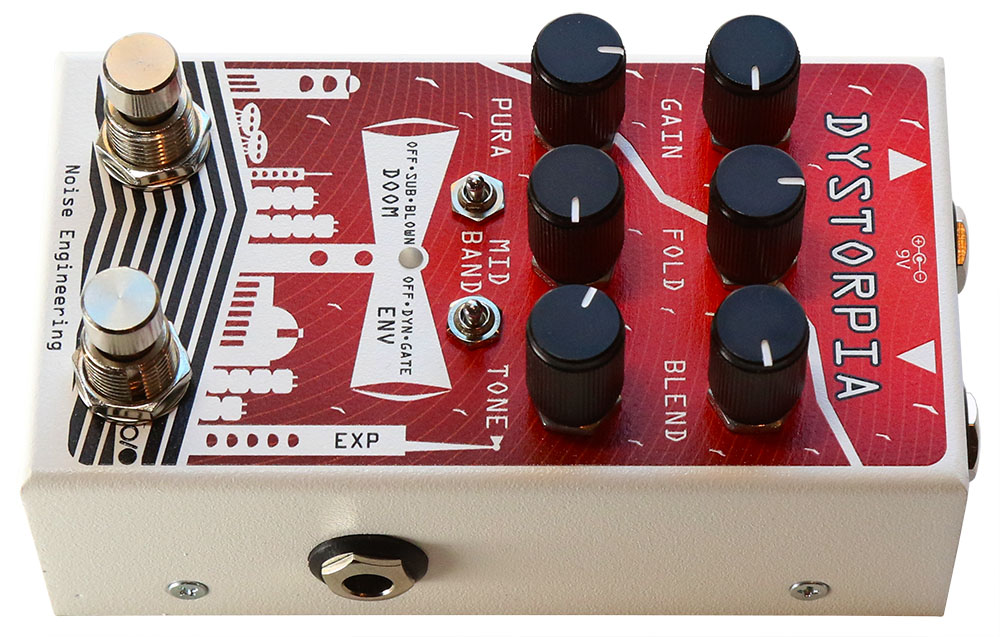
Noise Engineering Dystorpia – Expression:
- 1/4″ TRS Input for Expression pedal or control voltage.
- The expression input affects the Tone control.
- Control voltage responds to 0 to 5V and affects the position of the Tone knob.
- Manual
The concept of a product being “musical” is somewhat overused, and frankly over baked these days, but two of our more seasoned evaluators mentioned it in terms of the sound of Dystorpia. We asked Kaiser what she thought about the feedback, “Pura, one of the distortions, is a version of the octave fuzz that does a lot of filtering to clean up the produced harmonics so the generated octaves are much more audible than on the classic versions.”
“This gives a more consonant version of a classic effect but still retains some of the wonderful grit (unlike an actual pitch shifter)” Kaiser continues. This plays pretty well with the Fold distortion which is an all-out obliterator of consonance. I think there is a fundamental misperception about the qualities of digital that is based on some older digital gear that didn’t benefit from the processing options we have now. There are a lot of mistakes that can be made with DSP that will add artifacts to the signal that give it a sort of bad metallic crunch or unrelated (in)harmonics. Often these artifacts appear because the creator had to make some hard choices to get the product working on the available hardware. With the power of modern embedded hardware, there is no excuse for this sort of issue. As a simple example, Dystorpia runs at 96kHz/24Bit. This gives options dealing with aliasing that are not possible to implement transparently at 48k. We have a lot of experience working in this world with more than 40 effect or oscillator products (both analog and digital) across our three lines, modular, plug-ins and now guitar pedals, and Dystorpia has the lessons learned from all of them in making digital sound great.”

The easiest way for electronic musicians to get their music onto Spotify, Apple Music, iTunes, Amazon Music, Tidal, Instagram, Facebook, TikTok, Pandora, Twitch & much more! Click the banner above or the Go Button to save 7% off of your signup! Go!
In our long-term evaluation, our reviewers all agreed that Noise Engineering brought valuable and something new to the distortion pedal market with Dystorpia for guitarists. The sound has that “crunch and grit that you’re after,” but also “rounds the corners” to a degree making the “tone less fragile when pushed.” What we learned after from Kris Kaiser, is that Noise built this ability into the architecture. “One of our design goals is to always make the knobs go a little further than we feel it should top out because someone out there is going to love that bit.”
Our synth reviewers cited the Blend feature (also noted by guitarists) who like the “deep fried” saturation when dialed up. Our sound designer noted the interplay between the Pura and Fold controls to not only experiment with textures and “sand in the gears” but also to “add dimension to pads” that require “something extra to cut through.”
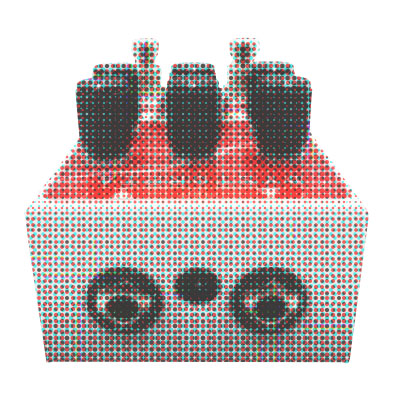
Our reviewers were less enthusiastic about the Freeze feature, which momentarily loops the signal, often just resulting in “mud” or “a complete washout without any definition.” Guitarists were more forgiving, but stated that they would rather employ a dedicated looper instead of utilizing this feature, which has minimal positive impact.
Finally, we do have to mention the price, which is on the higher end of the spectrum, especially for a mono guitar pedal. While guitar pedal prices have skyrocketed in the last decade, a dedicated distortion pedal for $400 bucks may be a hard pill to swallow. It will “instantly weed out the tire kicker” who is looking for a new distortion pedal, according to one of our testers, but someone “who is looking for a boutique offering that brings a new dimension to sound mangling, will find it compelling, either on its own or as part of their chain.”
Conclusion
If you’re a connoisseur of distortion effects and are looking for a pedal that can not only provide the crunch and fuzz, but can dynamically react to your playing, this pedal could be your new best friend. It goes hard without biting, gets aggressive wearing a cardigan, and can smack things around without incurring an arrest for assault. Highly Recommended.
Noise Engineering Dystorpia Rating: 90%
Cheers:
+ Sound Quality
+ Build Quality
+ Fold Function
+ Sophisticated Gnar
Jeers:
– Freeze
– Expensive
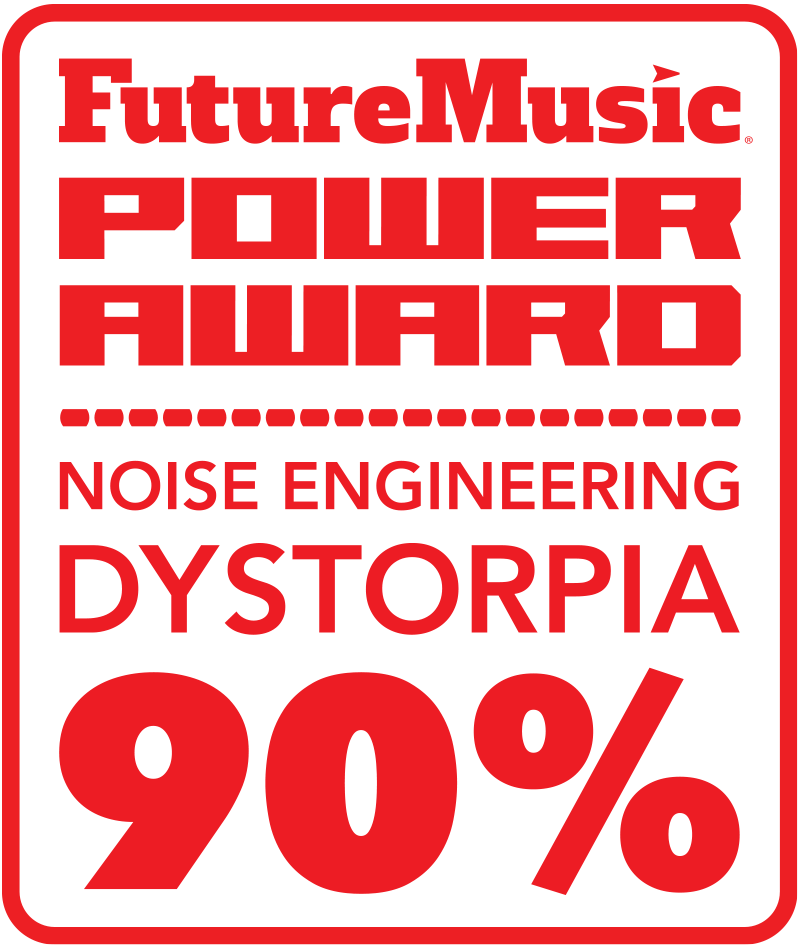
Noise Engineering’s Dystorpia costs $399.
The Future: It wasn’t much of a stretch to see Noise throw their hat into the guitar pedal ring since many of their modules can translate to this medium. However, Noise has demonstrated with Dystorpia that they’re willing to put in the hard work and thinking to bring something new to the market that differentiates them from other offerings. We certainly hope this continues with new pedals in the future.
That said, for the next incarnation of Dystorpia, we’d like to see the Freeze function replaced with something that “pushes” the dialed in distortion to new heights (or lows). Exploring the saturation arena that is hinted at with Blend, may be a good place to start. Freeze can be a great feature for reverb, micro loopers and delay, but on Dystorpia, it just turns the material into cement.
Although Noise Engineering said they have no immediate plans for a plug-in version of Dystorpia, we think it could be savvy move, especially if they expand the aforementioned saturation, and provide deeper control of the Doom section.

